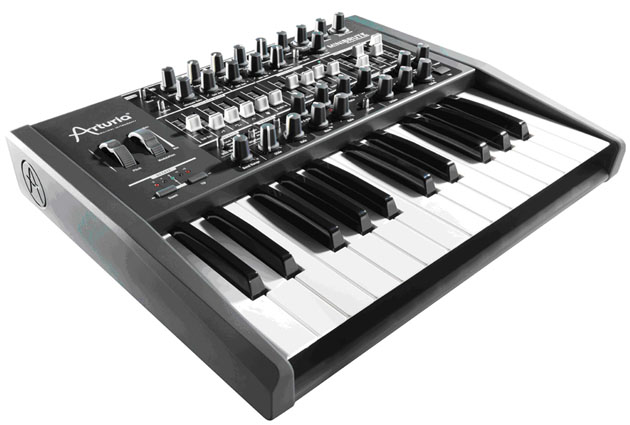Last year Arturia surprised us with the announcement and release of the MiniBrute, an analogue hardware synth. Arturia is mainly known for their software products, however they are not complete strangers to hardware gear as they released the Origin synth in 2009. Recently we got a MiniBrute to play with and one of the first things you’ll notice is that this synth isn’t light weighted, even though it looks mini, with just a 25-keys keyboard.

Short Introduction
The MiniBrute is a analogue, monophonic synth with a 100% analogue signal path. Next to Midi and USB it has a CV In and Out for pitch, filter, amp and gate. So Arturia didn’t forget our friends with modular systems.
Its single VCO feeds the VCF and VCA. The arpeggio is software controlled, so it’s maybe not completely analogue, but that shouldn’t spoil the fun. With the six channel control mixer you can control each waveform directly. The synth has also a sub-oscillator. Another nice feature is a Audio In that can function as a sound source, so you’ll have lots of opportunities to ‘built’ sounds. Let’s do this, shall we…?
Now, this is where I stumble upon a little problem or issue. The MiniBrute has no presets. Not that you, or I, need those to create a sound. But presets often give you a first impression of what a device is able to. But even that isn’t the biggest issue, the real problem is that you can’t save a preset/sound you have created. Not even via an USB dump. To be honest that’s a bit strange as the synth comes from a company with lots of ‘software‘ experience. A software editor should almost be obligatory nowadays. Or are we ‘gearheads’ spoiled and should we go back to our ‘synth’ roots?
The rotary knobs on the Brute feel solid and nice. The faders feel a bit weak, and when you use them a bit ‘rough’ they even ‘leak’ midi signal. The keys feel nice with a little tight spring, which I personally like. Like I mentioned before it has 25 keys, which are weighted. If you need more keys you could connect a midi keyboard. The key transpose button has a range of -2 till +2 octave, which I didn’t mind really.

Sound
Okay then, lets make some noise (sound)! The MiniBrute comes with some overlays with some ‘visual’ presets. This looks a bit ‘clumsy’ but it does the trick effectively. On empty overlays you could fill in your own presets for future reference, with pen! That’s what I mean with a little clumsy. I start with the creation of a little bass, and that went pretty quick and easy. The sound is good and the operation (creation) will be easy for anyone with some degree of ‘synth-knowledge’. With the sub-oscillator you even get a little extra low edge. The sub-osc has a sinus and pulse wave and goes 1 or 2 octaves below the oscillator pitch, depending of your choice.
The MiniBrute can also ‘tear it up’. It has an Ultrasaw that’ll give an extra raw edge to your sound. What actually happens is that he returns two phase copies to the signal. This is a constant 1 Hz frequency you can control with the LFO, creating a chorus-like effect.
The multi-mode filter is a 12 dB low pass and a 6 dB high pass filter with a band-pass mode. The filter sounds very nice and direct with a Moog-like sweep to it. Arturia realised you could send the audio signal of a Minimoog back to the filter for a fatter sound. For this you can use the MiniBrute’s gain.
Don’t expect any effects on the MiniBrute, as it has none. However there is an arpeggiator. Simple to operate with a hold, on/off mode, multiple steps over 4 octaves and a swing function. You could sync the arp via the Midi clock or use the taptempo function.
Verdict
Maybe I could write 5000 words on the Brute, …. but I wont. I just wanted to give a global insight in its sound and operation. The MiniBrute sounds great, feels really solid and, important in my view, has a big fun factor. With a price tag of just under 500 Euro this synth is an addition to any synth setup, or homestudio. Even with the preset issue it could be a great synth to start with for anyone who wants to get into hardware (analogue) synths.
I like it, and … I want one!

